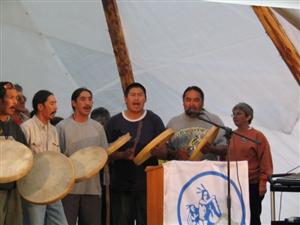The Dene
Some 14,000 to 10,000 years ago there were a series of migrations of people from the Old World by way of the Bering land bridge, which once connected Siberia and Alaska. This crossing is preserved in Dene legends (Petitot 1875:173; McCullough & Maccagno 1991). According to this “first story from time immemorial, the homeland [Denendeh] of the Dene nation was imagined to be the remnants of a great Arctic giant whose fallen form had forever left an imprint on the landscape” (Coutu & Hoffman-Mecredi 2002:17). Dene ‘clans’ in the region included the Chipewyan, Beaver, Slavey, Dogrib, Sarsi, and Yellowknife peoples (Coutu & Hoffman-Mercredi 2002).
The Etthen eldeli Dene, or ‘caribou eaters’ occupied territories that stretched from the Yukon to the western shores of Hudson’s Bay. Barren ground caribou formed the centre of the Etthen eldeli Dene culture, and peoples’ movements mirrored the migration patterns of the caribou. "The families would live, trap and hunt together, traveling in groups depending upon the season and the activity. They developed a communal trapping area system that was a natural evolution of their earlier cooperative caribou-hunting system" (ACFN 2003b). The colonizing effects of the fur trade, the arrival of the missionaries and various epidemics resulted in some of the descendents of the Etten eldeli Dene eventually settling in the Peace-Athabasca Delta region in the northern portion of what is now known as the RMWB. These people became known as the K’ái tailé Dene or delta people (ACFN 2003a, b). The K’ai tailé Dene were and remain closely related to other Dene people living in the RMWB.









